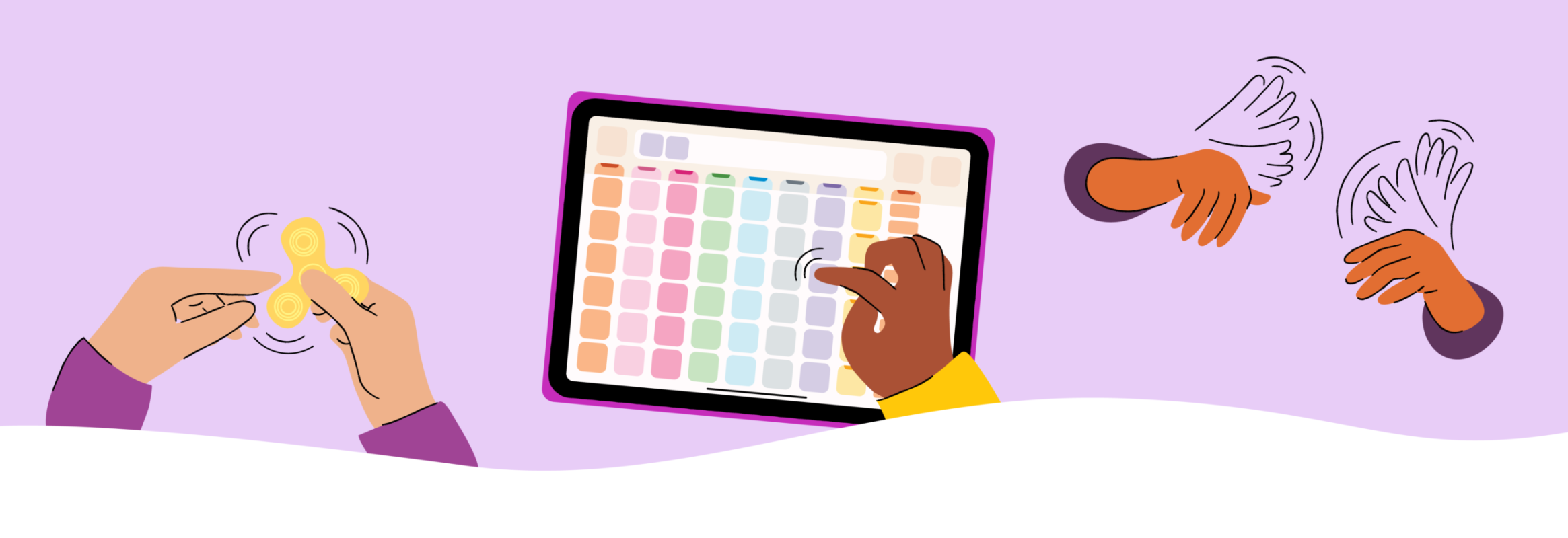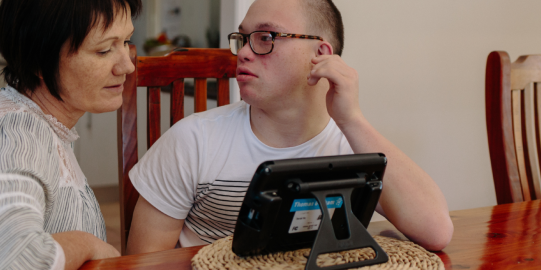What is stimming?
Stimming covers a wide range of ways people can move, make sounds, or otherwise seek sensory input to regulate their own sensory experience. However, most people only call something stimming when a neurodivergent person does it. Even then, only certain kinds of stimming might be called that. When an autistic person flaps their hands, rocks, jumps, or spins, it will probably be called stimming. When an AAC user repeats the same word over and over on their device, it might be called stimming, even if they are really trying to communicate.
On the other hand, someone who is presumed to be neurotypical probably won’t have their pen-clicking or hair-twirling called “stimming.” If they put one song on repeat, that probably won’t be called stimming either — though it probably would be if you add an autism diagnosis to the picture!
Everyone stims. Some people’s natural ways of stimming are more normalized, but we all do it. AAC users may stim in the same ways that fully speaking people do. In addition, much like speaking people may stim vocally by repeating particular words or phrases, and some AAC users may stim with their AAC.
Why do AAC users stim?
Whether or not they use their AAC devices to do it, AAC users stim for all the same reasons that everyone stims:
Regulating emotions: Stimming can help AAC users manage emotions such as anxiety, excitement, or frustration. For example, pressing the same button repeatedly might provide comfort during overwhelming situations, much like hand-flapping or rocking does for other individuals.
Expressing joy: Stimming isn’t always about managing stress. It can also be a way to express positive emotions. AAC users may press buttons over and over because they enjoy the word or phrase or like the sound the device makes. This type of stimming can be an expression of joy or excitement.
Managing sensory input: For some AAC users, stimming helps process and manage the sensory overload that comes with navigating complex environments. Repeated tapping may block out overwhelming stimuli and provide a familiar and predictable sensory experience.
However, it is important to keep in mind that repeated button presses are not always stimming. There are other purposes for repeated button tapping, including communication and device exploration. When in doubt, assume it's a communication attempt first.
Supporting AAC users who stim
Supporting AAC users who stim involves creating an environment where stimming is accepted, understood, and encouraged.
1. Acknowledge stimming as functional: Stimming serves a purpose for AAC users, whether it’s emotional regulation or sensory management. Avoid viewing it as disruptive or problematic; instead, recognize it as functional and essential.
2. Don’t assume repeated button tapping means someone is not ready for AAC: Stimming is deeply functional. Children and adults alike may stim while working through new ideas and concepts — like how to communicate with an AAC device! Similarly, tapping buttons over and over often can serve a function in their learning. It should not be interpreted as wrong. It certainly does not mean they are not ready for AAC.
3. Create stimming-friendly spaces: Everyone stims. Some AAC users may stim in ways that neurotypical people don’t. These AAC users need stimming-friendly spaces just like some people need quiet spaces. It should be possible to stim, including stimming with the AAC device, without judgment or interruption.
4. Try engaging with the stimming: If a user is stimming by repeatedly tapping a word or phrase, you can try engaging. Not everyone will like this, but it can build rapport and create an environment where they feel heard and accepted. You could say things like, “That’s a fun word!” or “I see you’re really enjoying that sound.” You might also repeat the word right along with them.
5. Encourage without forcing participation: Some users might enjoy stimming alone, while others are open to engaging with others. Pay attention to whether the AAC user wants others to join in their stimming or prefers solitude. Respect their boundaries and encourage stimming in a way that aligns with their preferences.
6. Explore related sensory activities: Depending on what aspects of repeated button pressing an AAC user finds most helpful, we can look for additional activities that are good for the same kind of stimming. If it’s the tapping, maybe they’d like percussion instruments. They might also like toys that have buttons to press. If they like the consistent rhythm of how words always sound the same from their AAC device, then percussion is relevant again. If they like how particular words sound, other words with similar sounds might be of interest. Stimming is important: we can look for more ways to stim.
By understanding and supporting AAC users’ stimming, we can create a more inclusive environment that respects neurodivergence and fosters communication and emotional well-being.
Punishments and rewards
In some cases, we see a person punished when stimming on their AAC device, as it is seen as noisy and distracting in the environment. The most common punishment is removing the device from the AAC user. Removing someone’s AAC device is never okay.
Depriving someone of the ability to communicate can damage relationships and negatively impact communication. In the long term, it can cause an AAC user to mistrust the adults around them and make them feel unsafe, unheard, and unimportant.
In other cases, we see stimming on a device used as a reward. For example, in a classroom, the teacher says: “Do your work, and then you can have your AAC device to stim.” If time to stim is used as a reward, but the AAC user is trying to communicate something, those communication attempts will be ignored. Withholding AAC and only providing the device to reward certain compliance can also have negative impacts. It implies that stimming is a privilege that has to be earned rather than a natural part of their experience and communication.





